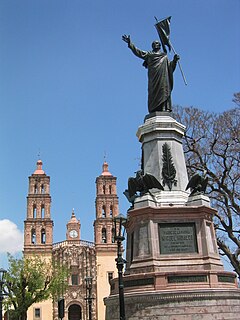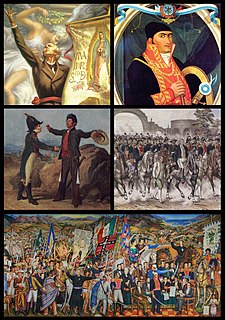This article needs additional citations for verification .(May 2019) |
| Die Stiere des Hidalgo | |
|---|---|
| Directed by | Karl Gass |
Release date | 1959 |
| Country | East Germany |
| Language | German |
Die Stiere des Hidalgo is an East German film. It was released in 1959.
This article needs additional citations for verification .(May 2019) |
| Die Stiere des Hidalgo | |
|---|---|
| Directed by | Karl Gass |
Release date | 1959 |
| Country | East Germany |
| Language | German |
Die Stiere des Hidalgo is an East German film. It was released in 1959.

Hidalgo County is located in the U.S. state of Texas. The county seat is Edinburg and the largest city is McAllen. The county is named for Miguel Hidalgo y Costilla, the priest who raised the call for Mexico's independence from Spain. It is located in the Rio Grande Valley of South Texas and is one of the fastest-growing counties in the United States. As of the 2020 census, the population of Hidalgo County was 870,781, making it the eighth-most populous county in Texas. Hidalgo County is designated by the U.S. Census Bureau as the McAllen-Edinburg-Mission metropolitan statistical area, which itself is part of the McAllen-Edinburg-Mission-Rio Grande City, Texas combined statistical area with neighboring Starr County.

Hidalgo is a city in Hidalgo County, Texas, United States. The population was 11,198 at the 2010 census, and in 2019 the estimated population was 14,183.

The Treaty of Guadalupe Hidalgo, officially the Treaty of Peace, Friendship, Limits, and Settlement between the United States of America and the Mexican Republic, is the peace treaty that was signed on 2 February 1848, in the Villa de Guadalupe Hidalgo between the United States and Mexico that ended the Mexican–American War (1846–1848). The treaty was ratified by the United States on 10 March and by Mexico on 19 May. The ratifications were exchanged on 30 May, and the treaty was proclaimed on 4 July 1848.

Don Miguel Gregorio Antonio Ignacio Hidalgo y Costilla y Gallaga Mandarte Villaseñor , more commonly known as Miguel Hidalgo y Costilla or Miguel Hidalgo, was a Catholic priest, leader of the Mexican War of Independence and recognized as the Father of the Nation.

The Cry of Dolores occurred in Dolores, Mexico, on 16 September 1810, when Roman Catholic priest Miguel Hidalgo y Costilla rang his church bell and gave the call to arms that triggered the Mexican War of Independence. The Cry of Dolores is most commonly known by the locals as "El Grito de Independencia".
Hidalgo may refer to:

Hidalgo, officially the Free and Sovereign State of Hidalgo is one of the 31 states which, along with Mexico City, constitute the 32 federal entities of Mexico. It is divided into 84 municipalities and its capital city is Pachuca de Soto. Located in the eastern part of the country, Hidalgo is bordered by San Luis Potosí and Veracruz on the north, Puebla on the east, Tlaxcala and State of Mexico on the south and Querétaro on the west.

The Mexican War of Independence was an armed conflict and political process resulting in Mexico's independence from Spain. It was not a single, coherent event, but local and regional struggles that occurred within the same time period, and can be considered a revolutionary civil war. Independence was not an inevitable outcome, but events in Spain itself had a direct impact on the outbreak of the armed insurgency in 1810 and its course until 1821. Napoleon Bonaparte's invasion of Spain in 1808 touched off a crisis of legitimacy of crown rule, since he had placed his brother Joseph on the Spanish throne after forcing the abdication of the Spanish monarch Charles IV. In Spain and many of its overseas possessions, the local response was to set up juntas ruling in the name of the Bourbon monarchy. Delegates in Spain and overseas territories met in Cádiz, Spain, still under Spanish control, as the Cortes of Cádiz, which drafted the Spanish Constitution of 1812. That constitution sought to create a new governing framework in the absence of the legitimate Spanish monarch. It tried to accommodate the aspirations of American-born Spaniards, for more local control and equal standing with Peninsular-born Spaniards, known locally as Peninsulares. This political process had far reaching impacts in New Spain, during the independence period and beyond. Pre-existing cultural, religious and racial divides in Mexico played a major role in not only the development of the independence movement but also the development of the conflict as it progressed.

Michel François Hidalgo was a French professional footballer and manager. He was the head coach of the French national team from 1976 to 1984, with whom he won the UEFA Euro 1984 on home soil, also reaching the semi-finals of the 1982 FIFA World Cup.

Sannois is a commune in the northwestern suburbs of Paris, France. It is located 15.2 km. from the center of Paris, in the Val-d'Oise department in Île-de-France in northern France.

Rubén Ramírez Hidalgo is a former professional male tennis player from Spain. His career-high ATP singles ranking is world No. 50, achieved on 2 October 2006. His favourite surface is clay, where he has won numerous ATP Challenger Tour events, and has reached the final in three events of the ATP tour, all in 2007, finishing runner-up in all three finals.

Félix Resurrección Hidalgo y Padilla was a Filipino artist. He is acknowledged as one of the greatest Filipino painters of the late 19th century, and is significant in Philippine history for having been an acquaintance and inspiration for members of the Philippine reform movement which included José Rizal, Marcelo del Pilar, Mariano Ponce, and Graciano López Jaena, although he neither involved himself directly in that movement, nor later associate himself with the First Philippine Republic under Emilio Aguinaldo.

Antonio Hidalgo Morilla is a Spanish former footballer who played as a central midfielder, currently a manager.

Ana María "Anne" Hidalgo Aleu is a Spanish-French politician who has served as Mayor of Paris since 2014, the first woman to hold the office. She is a member of the Socialist Party.
The Union Nationale des Footballeurs Professionels is the main trade union for professional football players in France. It was founded on 16 November 1961 by Eugène N'Jo Léa and Just Fontaine, two footballers, and Jacques Bertrand, a jurist. As of May 2021, the presidents of the UNFP are Philippe Piat and Sylvain Kastendeuch.

Valeria is a Venezuelan-American telenovela produced by Venevisión Productions. The telenovela premiered on Univision on March 10, 2009, at the 2pm/1c timeslot.
Louis Charles Kiener was a French malacologist born in Paris.
La Coupe de l'Outre-Mer de football 2010 was the 2010 edition of the Coupe de l'Outre-Mer. The competition took place from 22 September 2010 to 2 October 2010 in Île-de-France, France. It was Saint Pierre and Miquelon's first appearance in the tournament.
Isidro Pedraza Chávez was a Mexican politician affiliated with the PRD.

The Major and the Bulls is a 1955 West German comedy film directed by Eduard von Borsody and starring Fritz Tillmann, Christiane Hörbiger and Attila Hörbiger. It is based on the 1953 novel of the same title by Hans Venatier. It was shot at the Bavaria Studios in Munich and in Wiesbaden. The film's sets were designed by the art director Ernst Schomer.